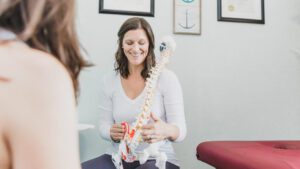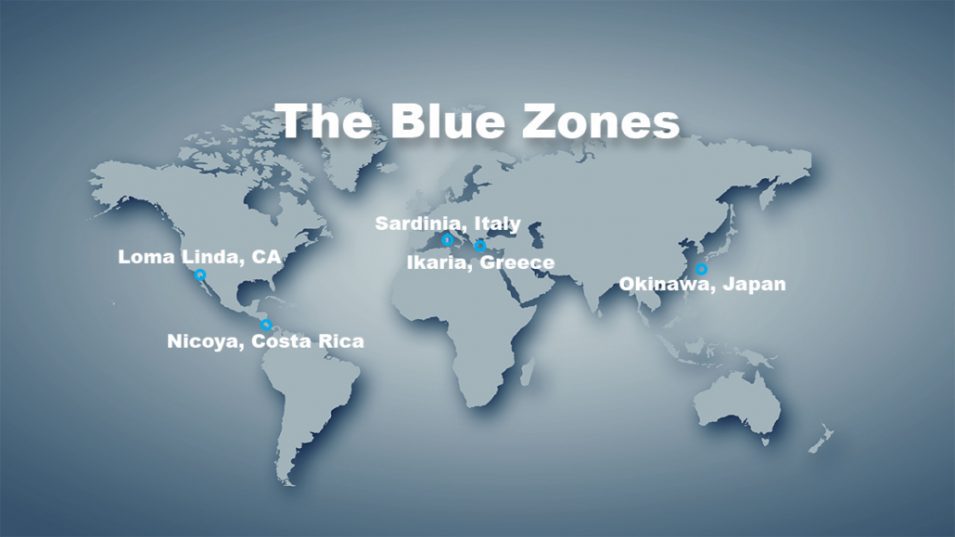Science suggests that 75% of how we live is determined by our lifestyles and everyday choices.. Humans are obsessed with deaging, dieting, and more. Yet, for most, none of these stick. For the few that live to reach 100 years of age in special regions of the world, something different exists to explain the longevity.
What are those special areas called? Blue Zones. Five locations around the world with a shocking influx of centenarians. These zones include Sardinia, Italy; Ikaria, Greece; Okinawa, Japan; Nicoya, Costa Rica; and Loma Linda, California. Research of these regions contributed to the well-known “Blue Zone diet” which in and of itself is a misnomer. Instead, it is a lifestyle.
National Geographic author and originator of the blue zones, Dan Buettner, along with several ethnographers, and anthropologists studied these five locations and identified nine similarities that they believe contribute to long life. So, what are these nine characteristics Buettner came up with, and how do they differ from popular life in the US?
The Power 9
Move naturally. Exercise is incorporated into these communities in the form of their daily activities, whether walking across villages to see old friends (Okinawa) or climbing mountains while tending sheep (Sardinia). Movement is essential to our greater wellbeing, both mentally and physically. Longevity researchers Venturelli, Schena, and Richardson note
Regular physical activity seems to be the most important lifestyle behavior that positively influences chronic disease risk factors. [In fact] the level of independence, lifestyle, and health of Japanese centenarians (566 men, 1341 women) were significantly correlated with the level of physical activity.
Sense of purpose. Intuitively they seem to have a great purpose, often related to their faith, in the general idea they were put on this earth for a reason. Furthermore, despite circumstances, they find themselves living for their family (as an example). This drive and purpose brings joy. The majority of our society, meanwhile, has a drive that is less of a deeper sense of purpose than it is a drive that turns human to machine.
Downshift. Blue Zones follow routines that shed stress. The drive of typical American culture’s work system does not always afford us the time we need to downshift. While we have seen an upswing in encouraging stress-relievers like yoga, we seem to constantly fill our lives with “busy.” Evidence strongly suggests that intense stress over time leads to the increase of disease (Cohen et al, 2007).
Belong. Aiding downshift, Blue Zone centenarians belong to a faith-based community. This allows a sense of connection which can decrease stress and increase the amount of support one feels. For the majority of America, work and gain are often the higher priority. Those in Loma Linda, CA take Sunday as a break from work and to center around their religion. The sense of belonging and the choice to downshift seem to be connected.
Loved ones first. Above work, family members are valued. Grandparents and parents are taken care of, people invest in a significant other, and children precede work. Modernized western culture, meanwhile, is primarily individualistic; the “I” is emphasized over the “we.”
80% rule. At 80% full, centenarians cease eating. Most Americans have an issue with overconsumption. Though not highest, we are ranked high on the food waste statistics for the world. According to the World Bank Development Indicators, “Americans eat roughly 200 billion more [calories] than needed.”
Plant slant. Vegetables, beans, and rice abound in meals. Meat is typically consumed around five times a month. Europe, in general, tends to consume less meat than America. Americans not only frequently consume meat, as noted by Buettner, but they also consume fattier meats. According to the CDC, 11.3% of daily food is fast food. Fast food consumption greatly contributes to a variety of diseases, which the Blue Zones’ people tend to be without.
Wine at 5. A glass or two a day is common practice. In America, drinking is often used as a social activity and alcoholism is a prevalent issue. Further, though, there are tangible, scientific differences between the drinks produced here and homegrown in the Blue Zones. Sardinian red wine, for example, is incredibly high in antioxidants and vitamins compared to American wines. The key here is moderation. One of the lesser known side effects of alcohol is the disruption of a health gut microbiome which can contribute to things like irritable bowel syndrome, anxiety and depression and more.
Right tribe. These are social networks that support healthy behavior in a community that primarily adheres to similar values. This principle is supported by researchers from UNC Chapel Hill who found that “higher degree of social integration was associated with lower risk of physiological dysregulation” (Yang et al, 2015).
Concluding Thoughts
What can we take away about health-consciousness and the desire to be healthier and live longer? Is the “Blue Zones diet” just another fad that is unsustainable and easily forgettable? Turning the Blue Zones into a “diet” seems to defeat its true purpose. Rather, what the Blue Zones studies tell us is that a life with purpose, intent, support, moderation and pleasure will contribute to longevity and well-being. Oh, and don’t forget your vegetables!
About the author:

Dr. Sarah Cash Crawford, PT, DPT, COMT, CMTPT, is a Physical Therapist and Certified Pilates Instructor. She has been a practicing physical therapy for over 10 years. With a background in neurologic rehabilitation, manual therapy and a specialty in treating chronic pain, Dr. Crawford has advanced training in orthopedic manual physical therapy and holds a certification in Geoffrey Maitland’s approach.
She was also the first student certified by Myopain Seminars in Dry Needling, holding her Certified Myofascial Trigger Point Therapist credentials since 2014. Dr. Crawford studied Pilates early in her practice to further expand her treatment options to help patients overcome physical limitations. Dr. Crawford is the founder of the Anchor Wellness Center, an integrated health and wellness collaborative.

